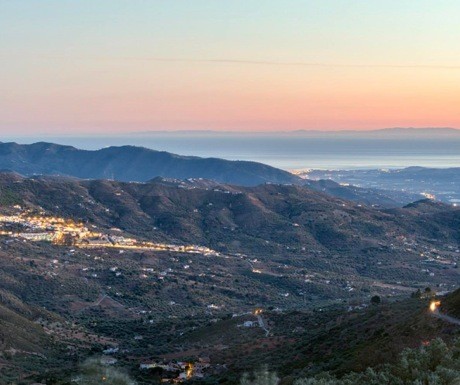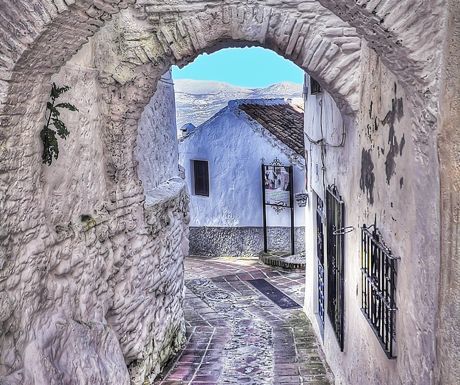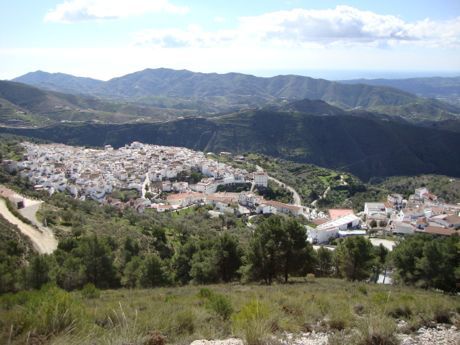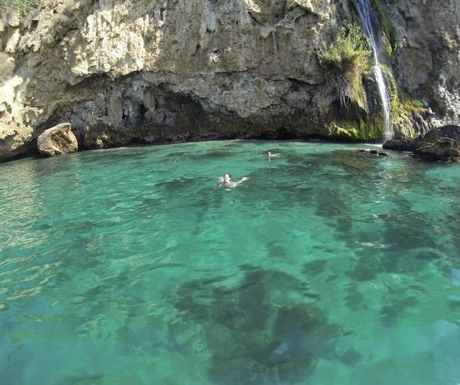Europe · Regions · Spain · Western Europe
Unsung Andalusia
Even with Spaniards outside of Malaga province, you’d be hard pressed to find many people that know the region of La Axarquia by name. It is a mostly sleepy and agricultural little area on the hilly, eastern edge of Malaga province, where the mountains meet the Mediterranean Sea. Goat herds dot the pastoral landscapes in between vineyards and olive groves, and its easy to slip back in time imagining a simpler age and way of life.
 There are actually a couple of recognisable villages in La Axarquia. For example, Frigiliana is oft listed amongst the most beautiful villages in all of Spain. And Nerja has long been a popular coastal destination with tourists that enjoy its pedestrianised shopping streets, upscale restaurants and pretty, accessible beaches punctuated by the viewing point known as the balcony of Europe jutting out to overlook the coastline in both directions. However, the majority of the pueblos of La Axarquia sit well off the beaten path and are as little known as the name of the region to which they belong.
For a taste of the authentic Spain and remembrances of times past, try a visit to some of these pueblos de La Axarquia.
Comares
The village of Comares sits perfectly perched atop a craggy hilltop at almost 740 metres high, exposing amazing views to the Mediterranean and the surrounding mountains. It is, in fact, so easy to get lost in this labyrinthine village that ceramic footprints have been placed along the narrow cobbled streets to help visitors find their way.
There are actually a couple of recognisable villages in La Axarquia. For example, Frigiliana is oft listed amongst the most beautiful villages in all of Spain. And Nerja has long been a popular coastal destination with tourists that enjoy its pedestrianised shopping streets, upscale restaurants and pretty, accessible beaches punctuated by the viewing point known as the balcony of Europe jutting out to overlook the coastline in both directions. However, the majority of the pueblos of La Axarquia sit well off the beaten path and are as little known as the name of the region to which they belong.
For a taste of the authentic Spain and remembrances of times past, try a visit to some of these pueblos de La Axarquia.
Comares
The village of Comares sits perfectly perched atop a craggy hilltop at almost 740 metres high, exposing amazing views to the Mediterranean and the surrounding mountains. It is, in fact, so easy to get lost in this labyrinthine village that ceramic footprints have been placed along the narrow cobbled streets to help visitors find their way.
 A wander around will reveal various plaques graphically explaining Comares rich history, dating to at least the 3rd century BC and including the handover of the village from the Moors to the Catholic Kings in 1487, plus numerous architectural sites also evidencing its Roman and Medieval past. Less than 25km from the coast, Comares is quite accessible though remains set apart from the typical tourist route, making it even more quaint and enjoyable.
Canillas de Aceituno
Positioned on the slopes of La Maroma, the tallest mountain in the province at more than 2000m, and only about 10km from the sea as the crow flies, Canillas de Aceituno offers unique views and a calming atmosphere. The locals are friendly and welcoming to visitors, but not overly eager to develop tourism in a commercial capacity, keeping the village in touch with and connected to its past.
A wander around will reveal various plaques graphically explaining Comares rich history, dating to at least the 3rd century BC and including the handover of the village from the Moors to the Catholic Kings in 1487, plus numerous architectural sites also evidencing its Roman and Medieval past. Less than 25km from the coast, Comares is quite accessible though remains set apart from the typical tourist route, making it even more quaint and enjoyable.
Canillas de Aceituno
Positioned on the slopes of La Maroma, the tallest mountain in the province at more than 2000m, and only about 10km from the sea as the crow flies, Canillas de Aceituno offers unique views and a calming atmosphere. The locals are friendly and welcoming to visitors, but not overly eager to develop tourism in a commercial capacity, keeping the village in touch with and connected to its past.
 For this it is all the more attractive to nature lovers and adventure seekers as well, with one of the primary trail heads leading from the village straight to the top of La Maroma and all through the expansive mountain nature reserve of the Sierra Tejeda. Although one of the final strongholds of the Moors in the region, evidence of the Moorish past in the village has largely been lost to time and conquest unless you know what to look for in the ancient aqueducts and water storage systems, hints of architectural remnants and the foundation of a long demolished castle. No visit to Canillas de Aceituno would be complete without sampling the roast kid, or chivo lechal for which the village is perhaps now most famous.
Maro
The coastal town of Maro is another wonderful example of a quaint Spanish village that has not been spoilt by commercialism or the so-called progress of time. Maro sits just three kilometres from Nerja and offers virtually everything that Nerja offers, though it has not experienced the same influx of tourists. The area was little known until 1959, when local youths discovered an expansive cave network complete with pre-historic cave paintings.
For this it is all the more attractive to nature lovers and adventure seekers as well, with one of the primary trail heads leading from the village straight to the top of La Maroma and all through the expansive mountain nature reserve of the Sierra Tejeda. Although one of the final strongholds of the Moors in the region, evidence of the Moorish past in the village has largely been lost to time and conquest unless you know what to look for in the ancient aqueducts and water storage systems, hints of architectural remnants and the foundation of a long demolished castle. No visit to Canillas de Aceituno would be complete without sampling the roast kid, or chivo lechal for which the village is perhaps now most famous.
Maro
The coastal town of Maro is another wonderful example of a quaint Spanish village that has not been spoilt by commercialism or the so-called progress of time. Maro sits just three kilometres from Nerja and offers virtually everything that Nerja offers, though it has not experienced the same influx of tourists. The area was little known until 1959, when local youths discovered an expansive cave network complete with pre-historic cave paintings.
 Today the remarkable and jaw-dropping Caves of Nerja (belonging to Maro) are a major attraction for visitors, though most of them still never make their way into Maro itself. The old 16th century sugar works and the 19th century Aguila Aqueduct are also notable sites in Maro. The village sits at the edge of La Axarquia where, to the east, the coast is unusually natural and unspoiled with cliffs falling into the sea and intermittent secluded beaches providing a quiet and beautiful haven for those who know how to find them.
These few villages are but representative of the many more that adorn La Axarquia on the coast, inland and up in the hills. One of the best ways to see La Axarquia is with a driving tour. From Canillas de Aceituno, for example, a windy mountain driving route leads from village to village along the Mudejar route, so called for architectural and historical remnants of an age when the Islamic Moors, Christians and Jews lived together harmoniously. The route inland from the heart of La Axarquia toward Cordoba leads through a majestic mountain landscape, past the iconic El Torcal nature park and to the ancient city of Antequera.
Plan your journey well, or wander on a whim; theres a new discovery of timeless landscapes and culture around every bend in La Axarquia.
Alan Hazel is Owner and Director of Cortijo El Carligto.
If you would like to be a guest blogger on A Luxury Travel Blog in order to raise your profile, please contact us.
Today the remarkable and jaw-dropping Caves of Nerja (belonging to Maro) are a major attraction for visitors, though most of them still never make their way into Maro itself. The old 16th century sugar works and the 19th century Aguila Aqueduct are also notable sites in Maro. The village sits at the edge of La Axarquia where, to the east, the coast is unusually natural and unspoiled with cliffs falling into the sea and intermittent secluded beaches providing a quiet and beautiful haven for those who know how to find them.
These few villages are but representative of the many more that adorn La Axarquia on the coast, inland and up in the hills. One of the best ways to see La Axarquia is with a driving tour. From Canillas de Aceituno, for example, a windy mountain driving route leads from village to village along the Mudejar route, so called for architectural and historical remnants of an age when the Islamic Moors, Christians and Jews lived together harmoniously. The route inland from the heart of La Axarquia toward Cordoba leads through a majestic mountain landscape, past the iconic El Torcal nature park and to the ancient city of Antequera.
Plan your journey well, or wander on a whim; theres a new discovery of timeless landscapes and culture around every bend in La Axarquia.
Alan Hazel is Owner and Director of Cortijo El Carligto.
If you would like to be a guest blogger on A Luxury Travel Blog in order to raise your profile, please contact us.
 There are actually a couple of recognisable villages in La Axarquia. For example, Frigiliana is oft listed amongst the most beautiful villages in all of Spain. And Nerja has long been a popular coastal destination with tourists that enjoy its pedestrianised shopping streets, upscale restaurants and pretty, accessible beaches punctuated by the viewing point known as the balcony of Europe jutting out to overlook the coastline in both directions. However, the majority of the pueblos of La Axarquia sit well off the beaten path and are as little known as the name of the region to which they belong.
For a taste of the authentic Spain and remembrances of times past, try a visit to some of these pueblos de La Axarquia.
Comares
The village of Comares sits perfectly perched atop a craggy hilltop at almost 740 metres high, exposing amazing views to the Mediterranean and the surrounding mountains. It is, in fact, so easy to get lost in this labyrinthine village that ceramic footprints have been placed along the narrow cobbled streets to help visitors find their way.
There are actually a couple of recognisable villages in La Axarquia. For example, Frigiliana is oft listed amongst the most beautiful villages in all of Spain. And Nerja has long been a popular coastal destination with tourists that enjoy its pedestrianised shopping streets, upscale restaurants and pretty, accessible beaches punctuated by the viewing point known as the balcony of Europe jutting out to overlook the coastline in both directions. However, the majority of the pueblos of La Axarquia sit well off the beaten path and are as little known as the name of the region to which they belong.
For a taste of the authentic Spain and remembrances of times past, try a visit to some of these pueblos de La Axarquia.
Comares
The village of Comares sits perfectly perched atop a craggy hilltop at almost 740 metres high, exposing amazing views to the Mediterranean and the surrounding mountains. It is, in fact, so easy to get lost in this labyrinthine village that ceramic footprints have been placed along the narrow cobbled streets to help visitors find their way.
 A wander around will reveal various plaques graphically explaining Comares rich history, dating to at least the 3rd century BC and including the handover of the village from the Moors to the Catholic Kings in 1487, plus numerous architectural sites also evidencing its Roman and Medieval past. Less than 25km from the coast, Comares is quite accessible though remains set apart from the typical tourist route, making it even more quaint and enjoyable.
Canillas de Aceituno
Positioned on the slopes of La Maroma, the tallest mountain in the province at more than 2000m, and only about 10km from the sea as the crow flies, Canillas de Aceituno offers unique views and a calming atmosphere. The locals are friendly and welcoming to visitors, but not overly eager to develop tourism in a commercial capacity, keeping the village in touch with and connected to its past.
A wander around will reveal various plaques graphically explaining Comares rich history, dating to at least the 3rd century BC and including the handover of the village from the Moors to the Catholic Kings in 1487, plus numerous architectural sites also evidencing its Roman and Medieval past. Less than 25km from the coast, Comares is quite accessible though remains set apart from the typical tourist route, making it even more quaint and enjoyable.
Canillas de Aceituno
Positioned on the slopes of La Maroma, the tallest mountain in the province at more than 2000m, and only about 10km from the sea as the crow flies, Canillas de Aceituno offers unique views and a calming atmosphere. The locals are friendly and welcoming to visitors, but not overly eager to develop tourism in a commercial capacity, keeping the village in touch with and connected to its past.
 For this it is all the more attractive to nature lovers and adventure seekers as well, with one of the primary trail heads leading from the village straight to the top of La Maroma and all through the expansive mountain nature reserve of the Sierra Tejeda. Although one of the final strongholds of the Moors in the region, evidence of the Moorish past in the village has largely been lost to time and conquest unless you know what to look for in the ancient aqueducts and water storage systems, hints of architectural remnants and the foundation of a long demolished castle. No visit to Canillas de Aceituno would be complete without sampling the roast kid, or chivo lechal for which the village is perhaps now most famous.
Maro
The coastal town of Maro is another wonderful example of a quaint Spanish village that has not been spoilt by commercialism or the so-called progress of time. Maro sits just three kilometres from Nerja and offers virtually everything that Nerja offers, though it has not experienced the same influx of tourists. The area was little known until 1959, when local youths discovered an expansive cave network complete with pre-historic cave paintings.
For this it is all the more attractive to nature lovers and adventure seekers as well, with one of the primary trail heads leading from the village straight to the top of La Maroma and all through the expansive mountain nature reserve of the Sierra Tejeda. Although one of the final strongholds of the Moors in the region, evidence of the Moorish past in the village has largely been lost to time and conquest unless you know what to look for in the ancient aqueducts and water storage systems, hints of architectural remnants and the foundation of a long demolished castle. No visit to Canillas de Aceituno would be complete without sampling the roast kid, or chivo lechal for which the village is perhaps now most famous.
Maro
The coastal town of Maro is another wonderful example of a quaint Spanish village that has not been spoilt by commercialism or the so-called progress of time. Maro sits just three kilometres from Nerja and offers virtually everything that Nerja offers, though it has not experienced the same influx of tourists. The area was little known until 1959, when local youths discovered an expansive cave network complete with pre-historic cave paintings.
 Today the remarkable and jaw-dropping Caves of Nerja (belonging to Maro) are a major attraction for visitors, though most of them still never make their way into Maro itself. The old 16th century sugar works and the 19th century Aguila Aqueduct are also notable sites in Maro. The village sits at the edge of La Axarquia where, to the east, the coast is unusually natural and unspoiled with cliffs falling into the sea and intermittent secluded beaches providing a quiet and beautiful haven for those who know how to find them.
These few villages are but representative of the many more that adorn La Axarquia on the coast, inland and up in the hills. One of the best ways to see La Axarquia is with a driving tour. From Canillas de Aceituno, for example, a windy mountain driving route leads from village to village along the Mudejar route, so called for architectural and historical remnants of an age when the Islamic Moors, Christians and Jews lived together harmoniously. The route inland from the heart of La Axarquia toward Cordoba leads through a majestic mountain landscape, past the iconic El Torcal nature park and to the ancient city of Antequera.
Plan your journey well, or wander on a whim; theres a new discovery of timeless landscapes and culture around every bend in La Axarquia.
Alan Hazel is Owner and Director of Cortijo El Carligto.
If you would like to be a guest blogger on A Luxury Travel Blog in order to raise your profile, please contact us.
Today the remarkable and jaw-dropping Caves of Nerja (belonging to Maro) are a major attraction for visitors, though most of them still never make their way into Maro itself. The old 16th century sugar works and the 19th century Aguila Aqueduct are also notable sites in Maro. The village sits at the edge of La Axarquia where, to the east, the coast is unusually natural and unspoiled with cliffs falling into the sea and intermittent secluded beaches providing a quiet and beautiful haven for those who know how to find them.
These few villages are but representative of the many more that adorn La Axarquia on the coast, inland and up in the hills. One of the best ways to see La Axarquia is with a driving tour. From Canillas de Aceituno, for example, a windy mountain driving route leads from village to village along the Mudejar route, so called for architectural and historical remnants of an age when the Islamic Moors, Christians and Jews lived together harmoniously. The route inland from the heart of La Axarquia toward Cordoba leads through a majestic mountain landscape, past the iconic El Torcal nature park and to the ancient city of Antequera.
Plan your journey well, or wander on a whim; theres a new discovery of timeless landscapes and culture around every bend in La Axarquia.
Alan Hazel is Owner and Director of Cortijo El Carligto.
If you would like to be a guest blogger on A Luxury Travel Blog in order to raise your profile, please contact us.Did you enjoy this article?
Receive similar content direct to your inbox.


I really like the idea of getting off the beaten track and into a region that is not heavily visited by tourists. I do enjoy visiting Spain, but must admit, I’d never heard of these places and am now intrigued. I wonder how many places to stay there are in this region, and how accessible it is regarding travel?
I love describing towns as sleepy, it makes them sound so appealing! I love looking at landscapes and seeing beautiful little animals dotted around, it makes you feel like you’re never alone on your travels. The Comares looks fantastic, I am such a sucker for cobblestoned streets
I spent a month in Spain last year and it clearly wasn’t enough since I didn’t see this area at all. Now I must go back. Thank you for this inspiration. Where would you recommend staying to see the area best?